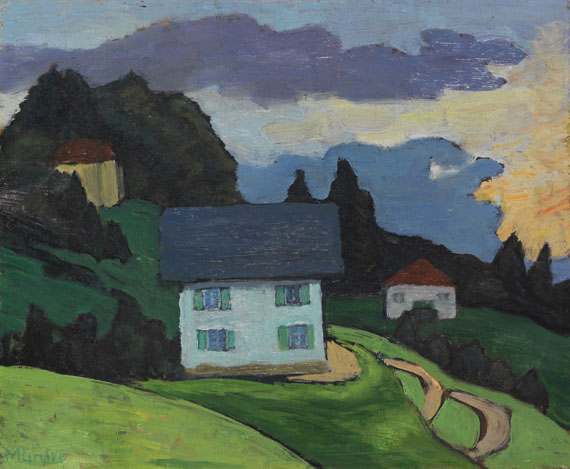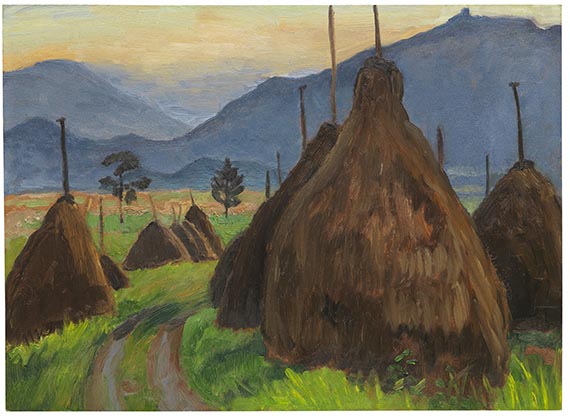231
Gabriele Münter
Blick auf Rue Lamblardie, Paris, Um 1930.
Oil on cardboard
Estimate:
€ 100,000 - 150,000
$ 110,000 - 165,000
Blick auf Rue Lamblardie, Paris. Um 1930.
Oil on cardboard.
Inscribed "42" on the reverse, as well as with an inscription by a hand other than that of the artist. Also with a label on the reverse with the the partly handwritten, partly stamped number "L 337". 37.5 x 55 cm (14.7 x 21.6 in).
• A charming view over the rooftops of Paris at night.
• Münter combined her three most famous subjects from this period – townscape, industrial motif, and the vibrant evening sky typical of her famous landscapes – to create this unique composition.
• The widely traveled artist (USA, Tunisia, Italy, Scandinavia) visited France a second time in 1929/30.
• In private ownership in Southern Germany for almost 55 years.
• This year, numerous international museum exhibitions (Vienna, Madrid, London, and Bern) celebrate Gabriele Münter.
The work is listed in Gabriele Münter's workbook from the year of its origin under the number 42, while the artist's estate registers it as “L 337”.
PROVENANCE: From the artist's estate (with the estate stamp on the reverse).
Art dealer László Kisgergely, Regensburg.
Private collection, Southern Germany (acquired from the above in 1970).
"[In October 1929] Münter decided to find new inspiration in Paris. It was a decision she would never regret."
Angela Lampe, curator at the Centre Pompidou, Paris, in: ex. cat. Gabriele Münter. Retrospektive, Leopold Museum, Vienna 2023/2024, p. 182.
Called up: December 7, 2024 - ca. 15.01 h +/- 20 min.
Oil on cardboard.
Inscribed "42" on the reverse, as well as with an inscription by a hand other than that of the artist. Also with a label on the reverse with the the partly handwritten, partly stamped number "L 337". 37.5 x 55 cm (14.7 x 21.6 in).
• A charming view over the rooftops of Paris at night.
• Münter combined her three most famous subjects from this period – townscape, industrial motif, and the vibrant evening sky typical of her famous landscapes – to create this unique composition.
• The widely traveled artist (USA, Tunisia, Italy, Scandinavia) visited France a second time in 1929/30.
• In private ownership in Southern Germany for almost 55 years.
• This year, numerous international museum exhibitions (Vienna, Madrid, London, and Bern) celebrate Gabriele Münter.
The work is listed in Gabriele Münter's workbook from the year of its origin under the number 42, while the artist's estate registers it as “L 337”.
PROVENANCE: From the artist's estate (with the estate stamp on the reverse).
Art dealer László Kisgergely, Regensburg.
Private collection, Southern Germany (acquired from the above in 1970).
"[In October 1929] Münter decided to find new inspiration in Paris. It was a decision she would never regret."
Angela Lampe, curator at the Centre Pompidou, Paris, in: ex. cat. Gabriele Münter. Retrospektive, Leopold Museum, Vienna 2023/2024, p. 182.
Called up: December 7, 2024 - ca. 15.01 h +/- 20 min.
The oeuvre of Gabriele Münter, who is currently recognized in several European exhibitions, including shows at the Museo Nacional Thyssen-Bornemisza in Madrid, the Tate in London, and the Leopold Museum in Vienna, has often been narrowed down to her landscapes, still lifes and village scenes from her time in Murnau. The artist fell in love with the quaint place in the foothills of the Alps in 1908, but it was only in 1930 that she settled for good in the small Bavarian town. In the meantime, she had done an astonishing amount of traveling: As early as 1899, she visited the USA with her sister; after the turn of the century, Münter and Wassily Kandinsky went to see Amsterdam, Marseille, Tunis, Brussels, Milan, and Bolzano; they stayed in Sèvres near Paris for almost a year and later also spent some time in Switzerland. Between 1915 and 1920, she lived in Scandinavia, initially in Stockholm, and later visited other regions of Sweden. Her then-largest solo exhibition took place in Copenhagen in 1918. In October 1929, the now-established artist once again visited the art metropolis of Paris before heading down south in September 1930. In Paris, she stayed at the Hôtel d'Odessa in the Montparnasse district. The city seemed to invigorate and inspire the painter. Just as she had in 1906, she took drawing lessons at the Académie de la Grande Chaumière and also joined the “Fédération des Artistes,” where she met numerous artists. Upon visits to theaters, cinemas, museums, galleries, and cafés, she observed the hustle and bustle of the city and its people. As a result, she created a small number of cityscapes, including “Paris, Villa Les Fleurettes” and “Baum an der Seine" (Tree on the Seine) (both in 1930, Gabriele Münter and Johannes Eichner Foundation, Munich).
In the present nocturnal cityscape (presumably Rue Lamblardie in the 12th arrondissement), Münter combines several key subjects of her work. The atmospheric evening sky in bold blue and pink is reminiscent of her landscapes inspired by the “Blue Land” in her Bavarian adopted home, and the illuminated house facades call Münter's famous depictions of the houses and streets in Murnau to mind, even if the multi-story buildings and the towers hinted at in the background (possibly the Eiffel Tower) suggest a big city. A small detail, a steaming asphalt machine, refers to motifs of “work and technology” that played an important role in earlier works made as of 1911, which she repeatedly revisited up into the 1930s. In these pictures, to which the Lenbachhaus in Munich dedicated an entire subchapter in the highly acclaimed exhibition in 2018, she shows construction sites and road workers, horse-drawn carts, cement mixers, and excavators. In Paris, she created, among other things, the painting “Baugerüst” (Scaffolding, 1930, Städtische Galerie im Lenbachhaus, Munich) as well as the work offered here, in which she skillfully combines her keen interest in machines and technology, as seen in the rising steam of the asphalt machine, with the atmospheric Parisian scenery in the evening. Hence, “Blick aus dem Fenster (Rue Lamblardie)” marked the beginning of a significant series that testified to Münter's innovative creativity and key role within European Modernism. [CH]
In the present nocturnal cityscape (presumably Rue Lamblardie in the 12th arrondissement), Münter combines several key subjects of her work. The atmospheric evening sky in bold blue and pink is reminiscent of her landscapes inspired by the “Blue Land” in her Bavarian adopted home, and the illuminated house facades call Münter's famous depictions of the houses and streets in Murnau to mind, even if the multi-story buildings and the towers hinted at in the background (possibly the Eiffel Tower) suggest a big city. A small detail, a steaming asphalt machine, refers to motifs of “work and technology” that played an important role in earlier works made as of 1911, which she repeatedly revisited up into the 1930s. In these pictures, to which the Lenbachhaus in Munich dedicated an entire subchapter in the highly acclaimed exhibition in 2018, she shows construction sites and road workers, horse-drawn carts, cement mixers, and excavators. In Paris, she created, among other things, the painting “Baugerüst” (Scaffolding, 1930, Städtische Galerie im Lenbachhaus, Munich) as well as the work offered here, in which she skillfully combines her keen interest in machines and technology, as seen in the rising steam of the asphalt machine, with the atmospheric Parisian scenery in the evening. Hence, “Blick aus dem Fenster (Rue Lamblardie)” marked the beginning of a significant series that testified to Münter's innovative creativity and key role within European Modernism. [CH]
231
Gabriele Münter
Blick auf Rue Lamblardie, Paris, Um 1930.
Oil on cardboard
Estimate:
€ 100,000 - 150,000
$ 110,000 - 165,000
Buyer's premium, taxation and resale right compensation for Gabriele Münter "Blick auf Rue Lamblardie, Paris"
This lot can be purchased subject to differential or regular taxation, artist‘s resale right compensation is due.
Differential taxation:
Hammer price up to 800,000 €: herefrom 32 % premium.
The share of the hammer price exceeding 800,000 € is subject to a premium of 27 % and is added to the premium of the share of the hammer price up to 800,000 €.
The share of the hammer price exceeding 4,000,000 € is subject to a premium of 22 % and is added to the premium of the share of the hammer price up to 4,000,000 €.
The buyer's premium contains VAT, however, it is not shown.
Regular taxation:
Hammer price up to 800,000 €: herefrom 27 % premium.
The share of the hammer price exceeding 800,000 € is subject to a premium of 21% and is added to the premium of the share of the hammer price up to 800,000 €.
The share of the hammer price exceeding 4,000,000 € is subject to a premium of 15% and is added to the premium of the share of the hammer price up to 4,000,000 €.
The statutory VAT of currently 19 % is levied to the sum of hammer price and premium. As an exception, the reduced VAT of 7 % is added for printed books.
We kindly ask you to notify us before invoicing if you wish to be subject to regular taxation.
Calculation of artist‘s resale right compensation:
For works by living artists, or by artists who died less than 70 years ago, a artist‘s resale right compensation is levied in accordance with Section 26 UrhG:
4 % of hammer price from 400.00 euros up to 50,000 euros,
another 3 % of the hammer price from 50,000.01 to 200,000 euros,
another 1 % for the part of the sales proceeds from 200,000.01 to 350,000 euros,
another 0.5 % for the part of the sale proceeds from 350,000.01 to 500,000 euros and
another 0.25 % of the hammer price over 500,000 euros.
The maximum total of the resale right fee is EUR 12,500.
The artist‘s resale right compensation is VAT-exempt.
Differential taxation:
Hammer price up to 800,000 €: herefrom 32 % premium.
The share of the hammer price exceeding 800,000 € is subject to a premium of 27 % and is added to the premium of the share of the hammer price up to 800,000 €.
The share of the hammer price exceeding 4,000,000 € is subject to a premium of 22 % and is added to the premium of the share of the hammer price up to 4,000,000 €.
The buyer's premium contains VAT, however, it is not shown.
Regular taxation:
Hammer price up to 800,000 €: herefrom 27 % premium.
The share of the hammer price exceeding 800,000 € is subject to a premium of 21% and is added to the premium of the share of the hammer price up to 800,000 €.
The share of the hammer price exceeding 4,000,000 € is subject to a premium of 15% and is added to the premium of the share of the hammer price up to 4,000,000 €.
The statutory VAT of currently 19 % is levied to the sum of hammer price and premium. As an exception, the reduced VAT of 7 % is added for printed books.
We kindly ask you to notify us before invoicing if you wish to be subject to regular taxation.
Calculation of artist‘s resale right compensation:
For works by living artists, or by artists who died less than 70 years ago, a artist‘s resale right compensation is levied in accordance with Section 26 UrhG:
4 % of hammer price from 400.00 euros up to 50,000 euros,
another 3 % of the hammer price from 50,000.01 to 200,000 euros,
another 1 % for the part of the sales proceeds from 200,000.01 to 350,000 euros,
another 0.5 % for the part of the sale proceeds from 350,000.01 to 500,000 euros and
another 0.25 % of the hammer price over 500,000 euros.
The maximum total of the resale right fee is EUR 12,500.
The artist‘s resale right compensation is VAT-exempt.




 Lot 231
Lot 231 




